|
An
historical event took place in the forests to the north of Kosta
village just before midday on the 20th August, 1968.
Sweden's
first hot-air balloon made her maiden voyage! Yet another reminder
of the Åfors Rocket and Balloon Club's existence.
Bertil
Vallien, 30 year-old artist at the Åfors glass-factory shared
the minimal basket with the balloon's constructor, Donald Piccard
from California, a legend in the art of balloon flying. With crash
helmets in place, Mr. Piccard adjusted the gas valve, and the 20
metre high Emilie, registration number SE-ZZA, was airborne!
Other
members of the club waited impatiently below for their turn. The
onlookers peered aloft somewhat anxiously at the yellow 'pumpkin'.
With an elevation capacity/speed of 8m per second, Vallien and Piccard
were soon up in the treetops. Emilie can only be steered up or down.
The balloon goes down if one opens the valve placed high in the
nylon canopy with the help of a rope in the basket. A sideways movement
lies in the hands of the elements. Considerable meteorlogical knowledge
is necessary to make a safe ascent. Very soon Emilie is rather too
close to the treetops and is soon anchored to the top of an oak.
But Donald Piccard knows what he is doing, and is going to teach
Bertil all the tricks of the balloonist (trade). They make a routine
landing a little later in the middle of a small roadway.
Few people
know that in 1957 Bertil Vallien was accepted by both the National
College of Art, Craft and Design and a fighter pilot training unit.
Other compelling interests were horses and music. We now know that
art held the greatest attraction for Vallien. He spent a few years
in the US before he and Ulrica put down their roots in the small
hamlet of Åfors to start their endeavours with glass and ceramics.
They thought that the little community needed livening up. So, in
1963, together with like-minded associates at Boda and Kosta (glass
factories), they launched "The Åfors Rocket and Balloon
Club", somewhat in protest against the penchant at that time
for forming societies. The informal presidents of the club were
Bertil Vallien and silversmith, Per Arne Lundahl from Växsjö.Some
of the other members were Ulrica, Erik Höglund, Monica Backström,
Göran and Ann Wärff, and photographer Ola Terje. All in
all some twenty members.
Bertil's
interest in the ethereal element grew. The following year the club
launched their very own "Spirit of Eriksmåla", home-made
out of fireproof paper and steel-wire. The three cubic metre sized
craft, carrying glass, ceramics and photographs disappeared into
thin air. (without a trace).
However, the Åfors Rocket and Balloon Club were above all,
a group interested in parties and mad escapades. They cast glass
in the snow, circulated an pornographic almanack called "Watch
It!" and fired off large rockets over Åfors lake. They
went on adding to the legend of creative dynamism in the Glass Realm.
Many made the pilgrimage to the glassworks to experience, for themselves,
the dizzying whirl and to buy their glass.
- In
the beginning we didn't intend to mess about with rockets and balloons.
We formed the club because we wanted to meet up and have fun, says
Bertil Vallien
Nonetheless,
the balloon enterprise grew and became ever more serious. During
the years 1963-68 as many as twenty five small unmanned balloons
were sent up. In 1968, whilst in Australia for an exhibition, Bertil
flew a balloon for the first time. He found this trip to be so enjoyable
that contrary to the advice of the Australian ballooners, he took
a detour to Los Angeles to meet with Donald Piccard. On arrival,
he ordered a balloon that would be delivered to Sweden within three
or four months. The cost was 20,000 Swedish kronor.
The Åfors
Balloon and Rocket Club decided to buy the balloon. Members contributed
250 Swe. Kr. each and a bank loan took care of the rest. The loan
was later paid back with the earnings from an exhibition of members'
work at Transjö. Piccard flew 'Emelie' over the Atlantic to
share his knowhow for a few weeks before it was time for Lift Off
Day.
As the Board of Aviation could not give him permission to land in
Sweden, Piccard had to land in Denmark and travel by car with the
balloon to Åfors. At that time balloon flying was almost forgotten
(a thing of the past) in Sweden. The Swedish Aviation Board had
no guidelines for such an endeavour, so they had to consult with
the Åfors Balloon and Rocket Club on the matter of regulations.
The third
hot-air balloon in Europe was now on Swedish soil for the first
time. Emelie had a capacity of 1,600 cubic metres air and could
carry a cargo of 450 kilograms. The wicker basket was so low that
one had to wear crash helmets to land in one piece. The width of
the balloon was 16 metres in diameter, the material made of an anti-inflammable
textile.
In addition to the 20,000 SEK came costs of 5000 SEK for gasol and
a burner. In 1968 running costs were 12 kronor per hour. Donald
Piccard became very thoughtful when he saw the Småland forests
and is supposed to have said the following:
-If your balloon is still in existence in two years time then you
are the world's best aviators!
Emelie's
first flight /lift-off evoked great interest in the media with both
Swedish Television and the national newspapers reporting the event.
Donald Piccard's mission was to train BV and P A Lundahl as pilots.
They in their turn were to teach the other members. The ÅR&B
Club continued to fly during the seventies, though less frequently.
Nowadays Emelie is to be found at the home of P. A Lundahl in Växjö.
She made a comeback in the summer of 2001, for Åfors' 125
year jubilee celebrations, when with balloon fully unfurled, Emelie,
alas, remained grounded!
|
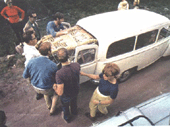
The
members of Åfors Rocket and Balloon Club´s pull out
the balloon from Bertil´s Volvo Duett.
Photo: Ola Terje.

Fr.
left: Björn Ramél, Erik Höglund och Bertil.
Photo: Ola Terje
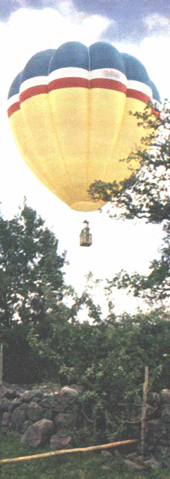
Up,
up and away!
Photo: Ola Terje
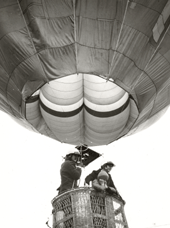
Those
balloonbaskets were small in the 60´s. Photo:
Ola Terje
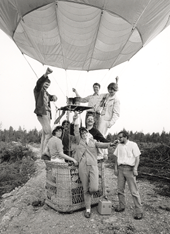
On
this picture you can see, for example: Rolf Sinnemark, Göran
Wärff, Ann Wärff, Per-Arne Lundahl. Photo: Ola Terje,
june 1969.
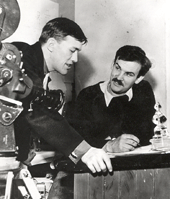
The
club´s activities draw some attention from media. Here, Swedish
Televison visit Åfors, fall 1965.
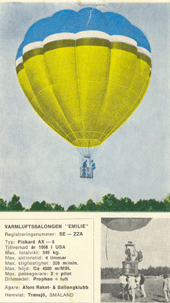
Sweden´s
first hot - air balloon became a postcard.
|


